So you’re researching your family, and found out that your ancestor is from the Netherlands. How do you go about finding that person in Dutch records? It’s often not that hard to find somebody with a similar name, but how do you go about proving that the person in Dutch records is the same as your immigrant ancestor and not a random namesake? Here are my top tips for you. The examples assume it is a 19th male century immigrant to the US, but the methodology works just as well for other eras and destinations or for females.
Phase 1: find out as much as you can in the country where he settled
The goal of this phase is to find enough information about your ancestor to be able to identify him in passenger lists or records in the Netherlands. This information includes:
- His name, plus any variations encountered in records
- His family members (parents, spouses, siblings, children) or other associates
- His (approximate) date and place of birth, marriage, death and emigration
- His occupation and religion
Find all records you can about your immigrant ancestor
Some must-have records include:
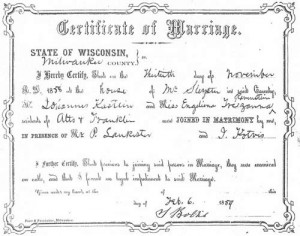
- Census records. These will show a country of origin. You want to make sure you’ve got an actual immigrant and not somebody who was born to immigrant parents shortly after they arrived.
In the US, 1880 and later federal census records don’t only show the birth place of the person, but also of his parents. Census records also provide information about the composition of the household. If your immigrant ancestor came over as a child, you may be able to find him in his parents’ home. The 1900 census also tells how long a couple was married. This can be used to estimate the marriage date. If this is before the emigration date, than the marriage took place in the home country and knowing the approximate date can be a big clue. - Naturalization records. These may give you the name of the town of origin as well as a birth date and tell you when and where he immigrated.
- Marriage and death records. These may give the parents’ names or even the place of origin.
- Obituaries. Obituaries about immigrants often tell when they arrived and where they came from. Family members may also be identified.
- Biographies. In the 19th century many towns published biographical sketches about their residents. Like obituaries, these often include background information about residents.
- Grave. The grave marker may include a birth date or even a place of origin.
- Wills or probate records. Wills or probate records may reveal bequests to relatives in the old country.
- Church records. Not only will this tell his religion, but also who he associated with.
Study his family, associates and neighbors
When you look at the records in step 1, don’t stop with your person of interest but note the other people in the records too. Then find out more information about the people he interacted with or lived next to, starting with the people he interacted with most often.
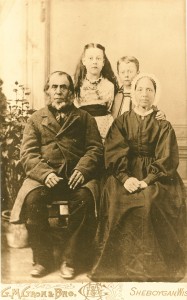
Hubregt Risseeuw Family. Source: Mary Risseeuw collection
- Family members. Obviously, knowing the names of the parents and siblings is going to help in tracing your immigrant ancestor in the passenger list or Dutch records. But even the names of children born after immigration can be a clue about earlier generations. Dutch people often named their children after their grandparents or predeceased spouses. Knowing about these naming traditions can help you create a theory about the names of the parents of your immigrant ancestor. The records of his children may also contain vital information. Biographical sketches often include information about the parents, so be sure to check if any of his children were featured in such an article. If you’re really stuck, collect the whole list of records mentioned in the previous step for all of his known relatives.
- Neighbors. When you go through the census records or land records, make a note of the people living in his neighborhood. Were any of his neighbors also from the Netherlands? They might have immigrated together. If the neighbor is easier to trace, he may lead you to a possible place of origin.
- Associates. What church did your ancestor go to? Who else worshiped at that church? Where did they come from? Who did your ancestor do business with? Who did he buy land from?
People didn’t suddenly form associations after they immigrated. Often, they traveled in groups and the people they were dealing with after immigration were the same people they dealt with in the Netherlands.
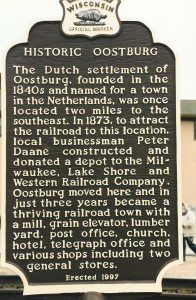
Study his community
Often, emigrants lived together in settlements of the same ethnicity. Try to find out where most immigrants came from in the area where your immigrant ancestor first settled.
- Town histories, some are available at Ancestry.com ($) or Google Books.
- Immigration literature, like the proceedings archives of the Association of the Advancement of Dutch-American Studies
- Genealogical magazines
Phase 2: Find out when and where he immigrated
Phase 1 will already have given you an idea of when your ancestor immigrated, even if it’s just a “before xxxx” date. The goal of this phase is to find out where and when he immigrated, as this can be used later to guess the place of origin and to rule out candidates.
Check passenger records
Try to find your person of interest in passenger records. Beware that passenger records often recorded the names in the original spelling, so make sure to use different types of search methods (wildcards, soundex) to look for these. See the article about English versions of Dutch last names and English versions of Dutch first names for more information about common name changes.
When you find a passenger record that matches the information you found in step 1, check the following information:
- What was his name, age, occupation?
- Who did he travel with? Check not only his own party (=people with the same last name) but also the other people on board of the ship, especially the families immediately before and after your family. They may have come from the same place of origin and traveled as a group.
- What was the port of departure? People who emigrated from Hamburg, Germany typically came from the northern provinces (Groningen, Friesland, Drenthe). People who emigrated from Amsterdam typically came from the province of Noord-Holland or Utrecht. People who emigrated from Antwerp typically came from the southern provinces of Zeeland, Noord-Brabant or Limburg. People who came from Rotterdam, the main port of the Netherlands, could have come from any province. It was the most popular port of embarkation for people from Overijssel and Gelderland.
- When did he arrive? Different areas of the Netherlands had different emigration waves. In the 1840s, most emigrants came from the provinces of Zeeland and Gelderland. In the 1880s, the provinces of Groningen and Friesland saw the most people leave.
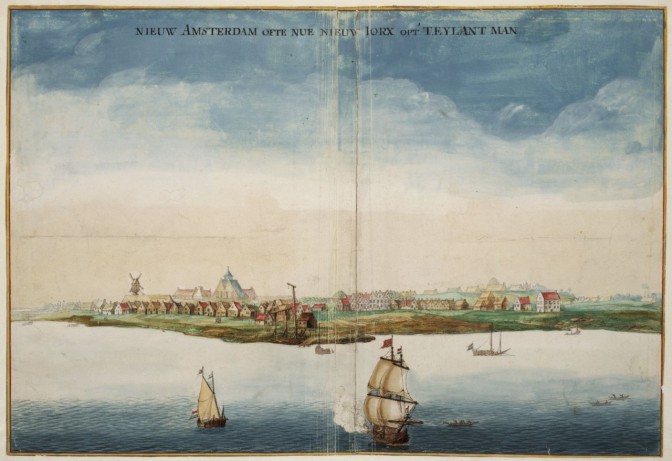
Johannes Vingboons, View of Nieuw Amsterdam (New York), c. 1655. Source: map collection Leupe, National Archives, the Netherlands.
Phase 3: Find candidates for your ancestor in Dutch records
If, and only if, the previous two phases have given you enough information about your ancestor to be able to identify him from all the other possible namesakes that you may come across, it’s time to try and find your ancestor in Dutch records. If you don’t have enough information, go back to phase 1 or 2 and find more records or find out more about family, neighbors and associates. If you don’t you may be barking up the wrong family tree as there are many dogs named Spot!
Keep in mind that what may seem like an unusual name to you (Gerrit, Tjeerd), may be a very common name in some regions of the Netherlands. Plus, Dutch people naming their children after relatives means there are often several cousins who went by the same name. You need to know exactly who your immigrant ancestor was, and what identifies him from all the other people in the world who were alive at that time.
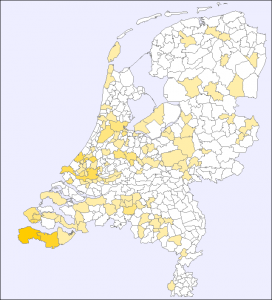
Map showing the distribution of the name Risseeuw in 2007. Source: Family names database
Find the place of origin
Knowing the place of origin is very helpful since many records are organized per geographical area. Phase 1 and 2 may have already given you a specific place of origin, or a hint about the province he may have come from.If you do not know the province or town of origin yet, there are some other options to make an educated guess:
- See where the last name occurs by searching the Family Names Database at the Meertens Institute.
- Try to see if the last name gives a clue. Different regions had different suffixes in last names.
Search in online indexes in the Netherlands
In the Netherlands, there are many online resources for genealogy, most of them free. Only some are available in English. To use Dutch websites, check out the Search Forms article for some translations of Dutch terms commonly found in search forms.
- WieWasWie is the largest database, a collaboration by all the archives in the capitals of the provinces. Most records are from the 19th century. This website is available in Dutch only. Use the “Personen zoeken” search box to search for names.
- Several provinces have their own genealogical websites, like AlleFriezen [All Frisians] for Friesland and Zeeuwen Gezocht [Searching for Zeelanders] for Zeeland. Some of them contain earlier records than available in WieWasWie. Check the Geography section of this website to find out specific tips for each province.
- Find specific online resources for the place of origin at the Digital Resources Netherlands and Belgium website.
These last two options only apply if you have some idea of the place of origin.
Phase 4: Research the Dutch person
If you’ve found a person in Dutch records during phase 3 that seems to match your immigrant ancestor, find out as much as you can about him. You’re basically looking for the same information as you were in records in the country of destination:
- His name, plus any variations encountered in records
- His family members (parents, spouses, siblings, children) or other associates
- His (approximate) date and place of birth, marriage, death and emigration
- His occupation and religion
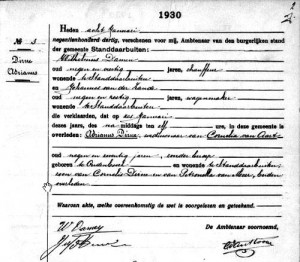
Dutch death record
Find more records about your candidate
- Birth, marriage and death records of him and his immediate family. Needless to say, if you find a death record in the Netherlands, this cannot be your immigrant ancestor (unless he returned, which immigrants rarely did).
- Population registers to find out who his neighbors were and to see when he emigrated and who he may have traveled with.
- List of emigrants 1848-1877 (select ‘achternaam bevat [last name contains]’ to search for a partial name).
- Death Duties Tax files from his parents to see if their list of heirs include a son living abroad. Sometimes even the spouses and towns where they settled are mentioned, which is about as good as it gets.
Phase 5: Confirm the identity
If you’ve successfully completed phases 1-4, you now have a well-documented immigrant ancestor and a Dutch person who you think may be the same person. Now it’s time to find out whether they are identical or just namesakes.
- Name. Are the names reasonably similar? Can any variations be explained by the new language they may have adopted?
- Family. Are at least some of the family members of the candidate in agreement with the immigrant? Are there any discrepancies that need explanation? For example: the names of the parents of the candidate do not match the names of the parents of the immigrant, but that can be explained because the father remarried and the stepmother was named instead of the mother. Also, does the composition of the household at the time of emigration match the household in the passenger lists or early census records?
- Birth place and date. Does the birth date of the candidate match your immigrant ancestor’s? Slight variations were not uncommon, for example: correct day and month but the year is off by one or two, or the correct month and year but the day is off a couple of days. Be sure to check who the informant was for the birth date of your immigrant ancestor. An unknown informant for the tombstone is much more likely to make a mistake than the person himself on his application for naturalization. Beware that he may have had a reason to lie about his age, for example to qualify for naturalization laws for people who came as minors or to enlist while underage or to avoid being drafted.
- Marriage place and date. If the person was already married prior to emigration, does the marriage date match the calculated date?
- Emigration. Did you find a record of emigration for the Dutch candidate? Did that data match the known date of immigration? Did other people from the region emigrate at the same time, and did they often settle in the same town as your immigrant ancestor?
- Associates and neighbors. Did your research into the Dutch candidate yield any references to associates and neighbors from the immigrant ancestor? If so, that’s a great confirmation that you’ve probably got the right person. If not, I recommend researching some of the associates and neighbors from the immigrant ancestor and repeating phase 4 for them to see if any of them are from the same place of origin.
- Occupation. Does the occupation of the Dutch candidate match your immigrant ancestor’s? If so, that’s a nice clue that you’ve got the right person, especially if they had a trade like carpenter or blacksmith. If not, it doesn’t say much as people often went on to do different things after emigrating.
- Religion. Does the religion of the candidate match the immigrant’s? Slight variations are to be expected, for example a Dutch Reformed joining the Reformed Church of America. However, it is very unlikely that a Roman Catholic would join a Quaker community, or a Jew a Dutch Reformed church.
- References to emigrant in Dutch records. Did the Dutch records refer to the emigrant living in the country of destination? People that emigrated don’t often feature in Dutch records after their emigration but when they do, it’s a big confirmation that you’ve found the right person, especially if there’s supporting identifying information like the name of the spouse or the town where he settled.
- Create a timeline. Does the person disappear from Dutch records before he appears in the records of the country where he immigrated to? If he still appears in Dutch records after supposedly emigrating, you’ve got a problem and this can’t be your guy.
If none of these tests disqualified your candidate, most of these tests showed a (partial) match and all of the discrepancies could be explained:


Hi Yvette, family history tells me that my ancesters came from Holland they were said to have come over to Ireland on the Ship “Brill” with William of Orange and Mary. The Dutch Army landed @ Brixham southwest England 5th November 1688, then made their way to Ireland for the Battle of the Boyne 1890. I can only trace back in Northern Ireland to my 4xGreat Grandfather born 1809 he was William Quinn his son was Hans Quinn, Hans also had sons William and Hans, the two names very prominant, is there anyway I could find a list of soldiers on that original Ship (Brill). Quinn is not a Dutch name but I saw a close name like Quinn but with a J on the end. I would be grateful if you could help Many Thanks Laura
Hi Laura,
Family lore can be totally right, totally wrong but in my experience is usually somewhere in between. For example: you may have had Dutch ancestors on the Brill but they may have been through a female line. Since Quinn is not a Dutch name that would be one plausible scenario.
I advise you to work back from the known to the unknown and first research your line back until the 1680s before trying to match with any potential soldiers on the Brill.
i wants to some family in netherland can you help me i know they name
As you can see from this article, knowing a name often is not enough. If you contact me through the contact form and let me know what you already know, I can advice you on your specific situation.